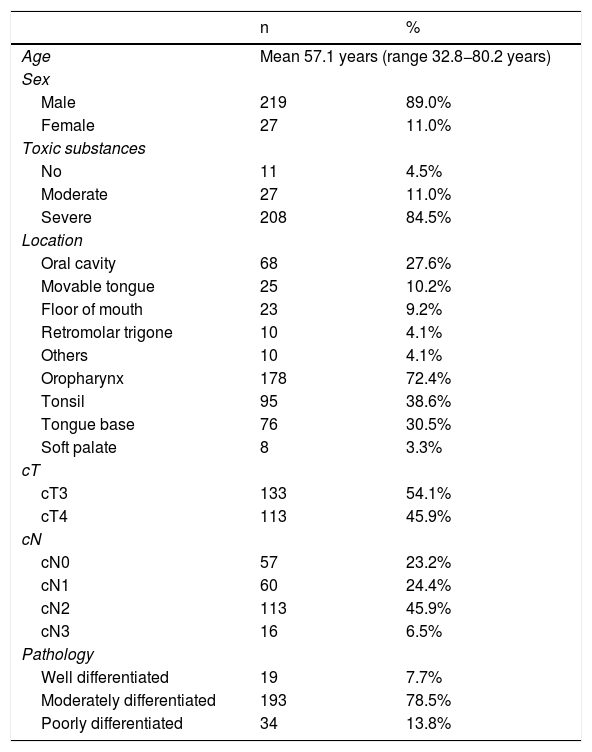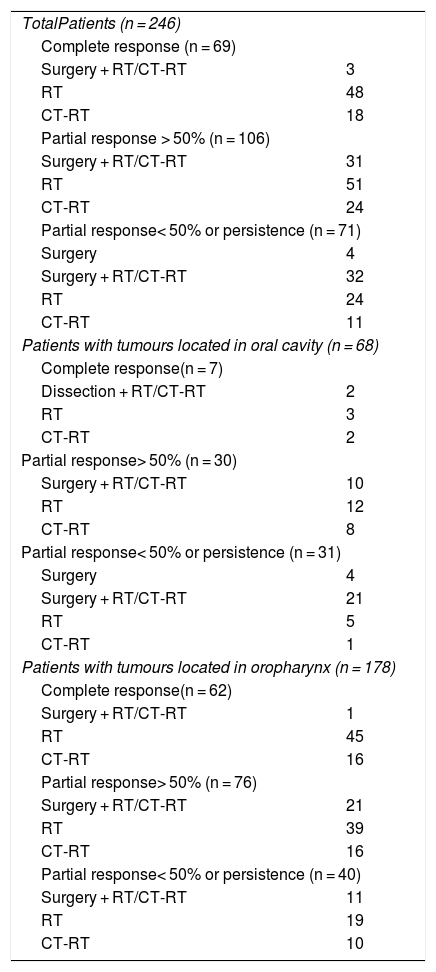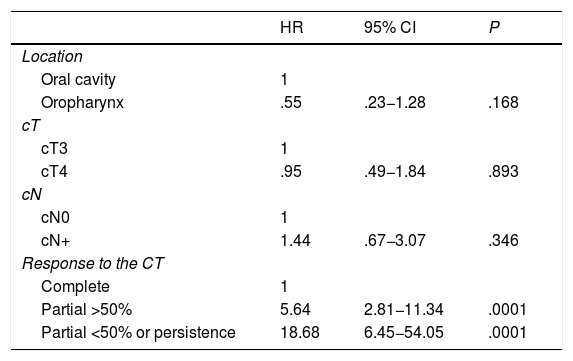With the goal of achieving functional preservation, one of the treatment strategies for patients with locally advanced squamous cell carcinomas of the head and neck is to initiate treatment with induction chemotherapy (CT) and decide the second therapeutic manoeuvre depending on the response. The objective of this study is to evaluate organ preservation capacity based on this therapeutic approach in patients with tumours of the oral cavity and oropharynx.
MethodsA retrospective study of 246 patients with locally advanced carcinomas of the oral cavity or oropharynx (cT3-T4) initially treated with induction CT.
ResultsAfter induction CT 28% of patients achieved a complete response of the primary location of the tumour, 43.1% a partial response greater than 50%, and 28.9% a reduction less than 50% or persistence. After the induction CT treatment 70 patients (28.5%) underwent surgical treatment, and 176 (71.5%) radiotherapy (RT) or chemoradiotherapy (CRT). Considering the patients treated non-surgically (n = 176), organ preservation for patients with a complete response (n = 66) was 65.2%, for those patients with a partial response greater than 50% (n = 75) it was 30.7%, and for patients with a partial response less than 50% or persistence (n = 35) it was 14.3%.
ConclusionThe response to treatment with induction CT has prognostic value in patients with locally advanced carcinomas of the oral cavity and oropharynx. Patients who are candidates for conservative treatment with RT or CRT would be those who achieve a complete response after induction treatment.
Con el objetivo de conseguir la preservación funcional, una de las estrategias de tratamiento para los pacientes con carcinomas localmente avanzados de cabeza y cuello consiste en iniciar el tratamiento con QT de inducción (QT) y decidir la segunda maniobra terapéutica en función de la respuesta. El objetivo del presente estudio es evaluar la capacidad de preservación de órgano basada en esta estrategia terapéutica en pacientes con tumores de cavidad oral y orofaringe.
MétodosEstudio retrospectivo de 246 pacientes con carcinomas de cavidad oral u orofaringe localmente avanzados (cT3-T4) tratados inicialmente con QT de inducción.
ResultadosTras la QT de inducción un 28% de pacientes consiguieron una respuesta completa de la localización primaria del tumor, 43,1% una respuesta parcial superior al 50%, y 28,9% una reducción inferior al 50% o persistencia. Tras el tratamiento de QT de inducción 70 pacientes (28,5%) recibieron un tratamiento quirúrgico, y 176 (71,5%) RT (RT) o quimio-radioterapia (QRT). Considerando a los pacientes tratados de forma no quirúrgica (n = 176), la preservación de órgano para los pacientes con una respuesta completa (n = 66) fue del 65,2%, para los pacientes con una respuesta parcial superior a 50% (n = 75) del 30,7%, y para los pacientes con una respuesta inferior al 50% o persistencia (n = 35) del 14,3%.
ConclusiónLa respuesta al tratamiento con QT de inducción cuenta con capacidad pronóstica en los pacientes con carcinomas localmente avanzados de cavidad oral y orofaringe. Los pacientes candidatos a tratamiento conservador con RT o QRT serían aquellos que consiguen una respuesta completa tras la administración del tratamiento de inducción.












